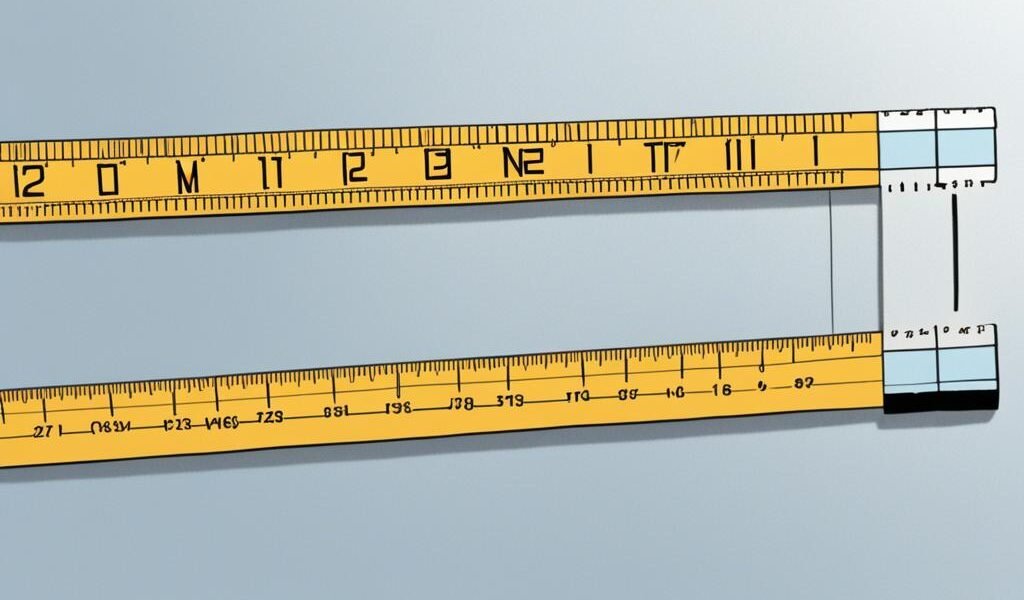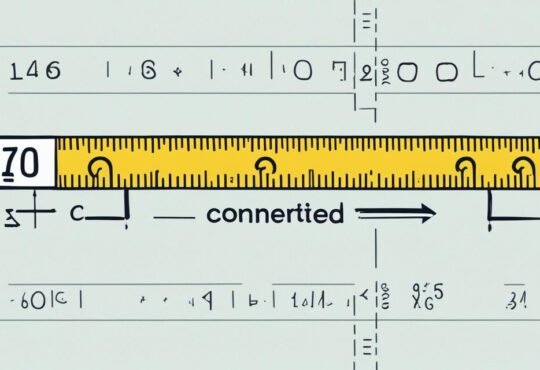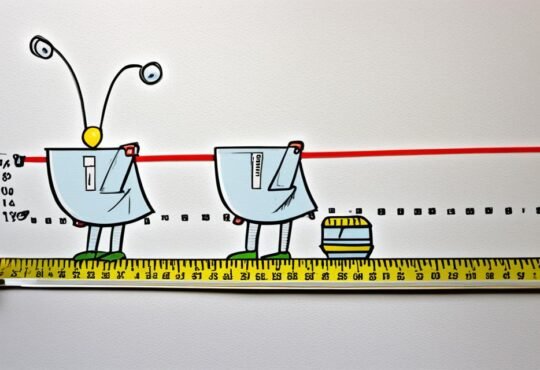
Convert 129cm to Meters – Quick & Easy Guide
If you’ve ever found yourself needing to convert centimeters to meters, you’re in the right place. Whether you’re working on a science project or trying to figure out your clothing size, understanding how to convert units of length is essential. In this guide, we’ll specifically focus on converting 129cm to meters, providing you with a quick and easy solution.
Converting centimeters to meters may seem complicated at first, but it’s actually a straightforward process. To convert 129cm to meters, all you need to do is divide the length in centimeters by 100. When you perform that calculation, you’ll find that 129cm equals 1.29 meters.
Whether you’re dealing with measurements for clothing, equipment, or scientific calculations, knowing how to convert centimeters to meters is valuable. By being able to make this conversion, you can ensure accurate and precise measurements for whatever task you’re working on.
Contents
Key Takeaways:
- Converting 129cm to meters is a simple process of dividing the centimeter value by 100.
- 129cm is equal to 1.29 meters.
- Understanding the conversion between centimeters and meters is essential in various industries and applications.
- Size charts are helpful tools for finding the right fit in clothing and equipment measurements.
- Always refer to the manufacturer’s or retailer’s size chart to ensure accurate sizing.
Converting Centimeters to Meters Made Easy
Converting centimeters to meters is a simple process that can be done in just a few steps. By understanding the conversion ratio between centimeters and meters, you can quickly and accurately convert any measurement from centimeters to meters. This conversion is frequently used in scientific and mathematical calculations, making it essential to grasp the concept.
To convert from centimeters to meters, you need to divide the value in centimeters by 100. The reason for this is that there are 100 centimeters in one meter. By dividing the centimeter value by 100, you effectively convert it into meters.
Let’s take an example to illustrate this conversion. Suppose you have a measurement of 150 centimeters that you want to convert to meters. Simply divide 150 by 100, and you will get the equivalent value in meters. In this case, 150 centimeters is equal to 1.5 meters.
Converting centimeters to meters is a straightforward process that you can easily accomplish using a calculator or by performing the division manually. By understanding this conversion, you will be able to work with measurements in different unit systems and perform accurate calculations.
Example:
Convert 175 centimeters to meters:
- Divide 175 by 100: 175 ÷ 100 = 1.75
- Therefore, 175 centimeters is equal to 1.75 meters.
Now that you understand how to convert centimeters to meters, you can apply this knowledge in various fields, such as scientific research, engineering, construction, and more. Whether you’re dealing with measurements for a project or simply curious about unit conversions, having a solid understanding of this conversion will prove valuable.
| Centimeters (cm) | Meters (m) |
|---|---|
| 100 | 1 |
| 150 | 1.5 |
| 175 | 1.75 |
| 200 | 2 |
Converting centimeters to meters is a fundamental skill that allows for accurate measurements and calculations. By understanding the simple division process involved, you can confidently convert any centimeter measurement to its equivalent in meters. Remember, divide by 100 to convert from centimeters to meters, and always double-check your calculations for precision.
Understanding Size Charts for Clothing and Equipment
Size charts are essential tools when it comes to finding the perfect fit for clothing and equipment. They provide detailed measurements and conversions to help you determine the right size. Whether you’re looking for a new pair of jeans or buying sporting gear, referring to a size chart ensures that you make an informed decision.
When using a size chart, accuracy is key. It’s important to take precise measurements and compare them to the chart to ensure you select the correct size. Keep in mind that sizes can vary between brands and even different countries, so it’s crucial to refer to the specific size chart provided by the manufacturer or retailer.
Let’s take a look at an example size chart for clothing:
| Size | Bust (inches) | Waist (inches) | Hip (inches) |
|---|---|---|---|
| XS | 32 | 24 | 34 |
| S | 34 | 26 | 36 |
| M | 36 | 28 | 38 |
| L | 38 | 30 | 40 |
Now, let’s say you’re looking for a dress and your bust measures 36 inches, your waist is 29 inches, and your hips are 39 inches. By consulting the size chart, you can determine that a size M would likely be the best fit for you.
In addition to clothing, size charts are also relevant for equipment. Whether you’re purchasing a new helmet, shoes, or gloves, the right fit ensures optimal performance and comfort. Here’s an example size chart for ski boots:
| US Women’s Shoe Size | Ski Boot Size (Mondopoint) |
|---|---|
| 6 | 23 |
| 7 | 24 |
| 8 | 25 |
| 9 | 26 |
Using the ski boot size chart, if you wear a US women’s shoe size 7, you would look for ski boots with a Mondopoint size of 24.
Remember, size charts are invaluable resources that can help you avoid the hassle of returns and exchanges due to incorrect sizing. Take the time to measure accurately, consult the appropriate size chart, and ensure a proper fit for your clothing and equipment needs.
Conclusion
In summary, converting centimeters to meters is a simple process that involves dividing the value in centimeters by 100. This conversion is widely used in various industries and applications, such as clothing sizing, equipment measurements, and scientific calculations.
By understanding how to convert centimeters to meters, you can ensure accuracy in determining the appropriate measurements for your needs. Whether you are shopping for clothes or using measurements in your professional or academic pursuits, knowing how to convert between these units is essential.
Additionally, size charts provide a helpful reference when it comes to finding the right fit for clothing and equipment. By taking accurate measurements and referring to the manufacturer or retailer’s size chart, you can select the size that best suits you.
Remember, sizes may vary between brands and countries, so it’s essential to rely on the specific size chart provided. By following these guidelines, you can confidently convert centimeters to meters and make informed decisions when it comes to selecting the correct size.
FAQ
How do I convert 129cm to meters?
To convert 129 centimeters to meters, simply divide the value in centimeters by 100. Therefore, 129cm equals 1.29 meters.
Why do we need to convert centimeters to meters?
Converting centimeters to meters is necessary when dealing with different units of length or when measuring large distances in smaller unit increments. This conversion is commonly used in scientific and mathematical calculations.
How do I convert centimeters to meters?
Converting centimeters to meters is a simple process. To convert from centimeters to meters, divide the value in centimeters by 100. There are 100 centimeters in a meter.
When should I use a size chart?
Size charts are helpful tools for determining the appropriate size for clothing and equipment. They provide measurements and conversions to help individuals find the best fit.
How do I use a size chart?
When using a size chart, it is important to take accurate measurements and compare them to the chart to ensure the correct size is selected. Sizes may vary between brands and countries, so it is important to refer to the specific size chart provided by the manufacturer or retailer.
Where can I find a size chart?
Size charts are often available on the websites of clothing brands or equipment manufacturers. You can also find size charts in retail stores or by contacting customer service for assistance.
Convert your measurements here: https://nosygeek.com/convertlive-cm-to-m







